BSC2086 General Senses: Terms & Definitions for Lesson 1
1/85
There's no tags or description
Looks like no tags are added yet.
Name | Mastery | Learn | Test | Matching | Spaced |
|---|
No study sessions yet.
86 Terms
receptor - structure specialized to ________ a ________
receptor - structure specialized to detect a stimulus
some receptors are ________ ________ endings
some receptors are bare nerve endings
other receptors are true ________ organs - structure that combines ________ tissue surrounded by other tissues that ________ response to a certain type of ________
other receptors are true sense organs - structure that combines nerve tissue surrounded by other tissues that enhance response to a certain type of stimulus
________ tissues may include: added ________, ________ tissue, or ________ tissue
accessory tissues may include: added epithelium, muscular tissue, or connective tissue
receptors range in ________ and ________; ________ and eye vs. a ________ wrapped in a little bit of ________ tissue
receptors range in size and complexity; ear and eye vs. a dendrite wrapped in a little bit of connective tissue
16.1 properties and types of sensory receptors
________ - structure specialized to detect a stimulus
- some ________ are ________ ________ endings
- others are true ________ organs - structure that combines ________ tissue surrounded by other tissues that ________ a response to a certain stimulus
~ ________ tissues may include: added ________, ________ tissue, or ________ tissue
~ range in ________ and ________: ________ and ear vs. a ________ wrapped in a little bit of ________ tissue
16.1 properties and types of sensory receptors
receptor - structure specialized to detect a stimulus
- some receptors are bare nerve endings
- others are true sense organs - structure that combines nerve tissue surrounded by other tissues that enhance response to a certain type of stimulus
~ accessory tissues may include: added epithelium, muscular tissue, or connective tissue
~ range in size and complexity: eye and ear vs. a dendrite wrapped in a little bit of connective tissue
________ - the conversion of one form of ________ to another
transduction - the conversion of one form of energy to another
fundamental ________ of any ________ receptor is to convert ________ energy (________, ________, ________ ________, etc) into ________ signals
fundamental purpose of any sensory receptor is convert stimulus energy (light, heat, touch, sound, etc.) into nerve signals
give 4 examples of stimulus energy
light, heat, touch, and sound
2 stages in the sensory process:
1) ________ - ________ receptor detects ________ and creates small ________ electrical charge (called ________ ________)
- if ________ ________ is strong enough, the neuron fires ________ ________ and ________ signal to ________
2) ________ - ________ experience and ________ of a stimulus
- not all ________ lead to ________ - many signals are filtered out before reaching ________
2 stages in the sensory process:
1) sensation - sensory receptor detects stimulus and creates small local electrical charge (called receptor potential)
- if receptor potential is strong enough, the neuron fires action potentials and nerve signal to brain
2) perception - conscious experience and interpretation of a stimulus
- not all sensations lead to perception - many signals are filtered out before reaching cortex
16.1a general properties of receptors
________ - the ________ of one form of ________ to another
- fundamental ________ of any ________ receptor is to convert ________ energy (________, ________, ________, ________, etc.) into ________ signals
2 stages in the sensory process:
1) ________ - ________ receptor detects ________ and creates small ________ electrical charge (called the ________ ________)
- if ________ ________ is strong enough, the neuron fires ________ ________ and ________ signal to ________
2) ________ - ________ experience and ________ of a stimulus
- not all sensations lead to ________ - many signals are filtered out before reaching ________
16.a general properties of receptors
transduction - the conversion of one form of energy to another
- fundamental purpose of any sensory receptor is to convert stimulus energy (light, heat, touch, sound, etc.) into nerve signals
2 stages in the sensory process:
1) sensation - sensory receptor detects stimulus and creates a small local electrical charge (called the receptor potential)
- if the receptor potential is strong enough, the neuron fires action potentials and nerve signal to brain
2) perception - conscious experience and interpretation of a stimulus
- not all sensations lead to perception - many signals are filtered out before reaching cortex
________ receptors transmit 4 kinds of information: ________, ________, ________, and ________
sensory receptors transmit 4 kinds of information: modality, location, intensity, and duration
list the 4 types of information sensory receptors transmit
modality, location, intensity, and duration
________ - ________ of stimulus or the ________ it produces
- determined by which ________ of the brain is "________" to receive the information, ex: ________, hearing, ________
- information is sent to the ________ via ________ ________ (the ________ signal of each ________ is passed along a chain of ________ to the ________ so that the information is separated from each other)
modality - type of stimulus or the perception it produces
- determined by which region of the brian is "wired" to receive the information, ex: vision, hearing, taste
- information is sent to the CNS via labeled line (the electrical signal of each modality is passed along a chain of neurons to the CNS so that the information is separated from each other)
________ - where a stimulus is ________
- encoded by which ________ fibers are ________
- ________ ________ - area within which a ________ neuron detects stimuli. The size of ________ ________ determines ________ (ability to distinguish between 2 close together ________)
~ neurons in ________ have ________, ________ ________ allowing for fine ________-________ touch ________
location - where a stimulus is located
- encoded by which nerve fibers are firing
- receptive field - area within which a sensory neuron detects stimuli. The size of receptive field determines resolution (ability to distinguish between2 close together stimuli)
~ neurons in fingertips have small, receptive fields allowing for fine two-point touch discrimination
receptive fields image figure 16.1
image
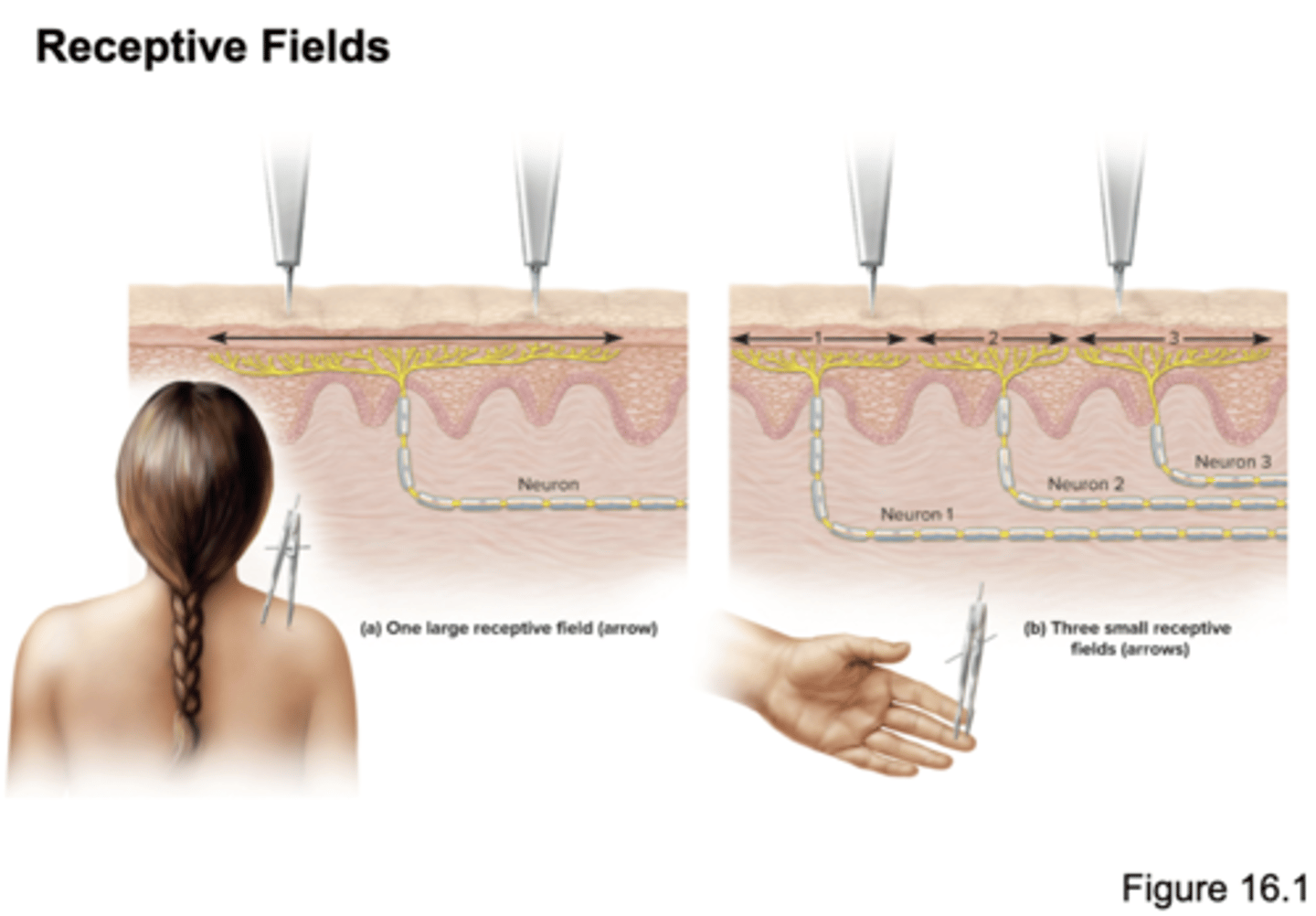
receptive fields image 2 figure 16.1
image
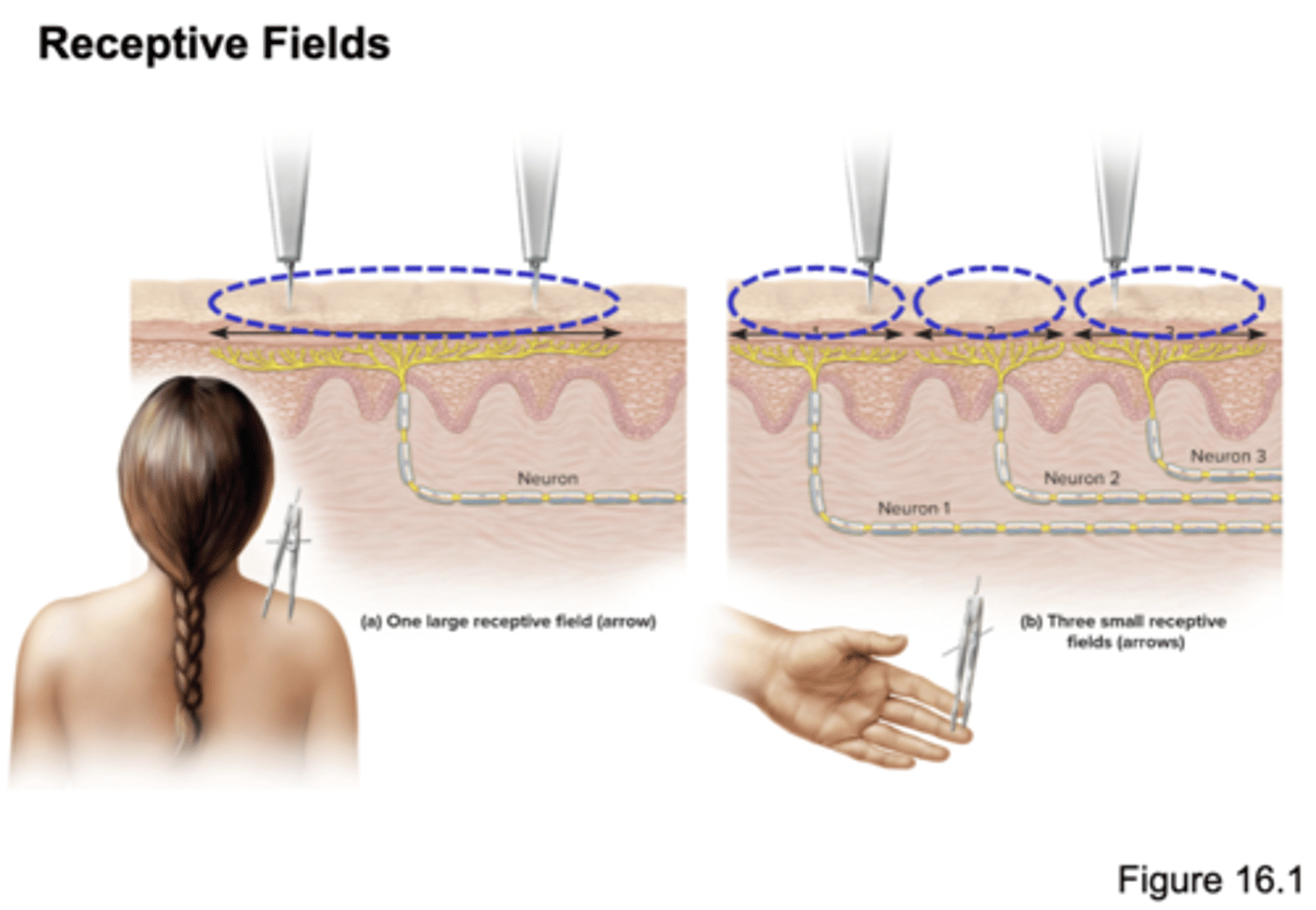
________ - ________ of stimulus
- ex: whether a ________ is loud or soft, a light is bright or dim, a pain is mild or excruciating, etc.
intensity is encoded in 3 ways:
1) which fibers ________- ________ stimuli can only activate most ________ neurons; ________ stimuli also activate MORE/LESS sensitive neurons with HIGHER/LOWER thresholds
2) how many fibers ________ - more ________ stimuli activate MORE/LESS neurons
3) how ________ the fibers are firing - as stimulus intensity ________, firing frequency ________ (________ a number of action ________ generated per second)
intensity - strength of a stimulus
- ex: whether a sound is loud or soft, a light is bright or dim, a pain is mild or excruciating, etc.
intensity is encoded in 3 ways:
1) which fibers respond - weak stimuli can only activate most sensitive neurons; strong stimuli can also activate less sensitive neurons with higher thresholds
2) how many fibers respond - more intense stimuli activate more neurons
3) how fast the fibers are firing - as stimulus intensity rises, firing frequency increases (increasing number of action potentials generated per second)
________ - how ________ stimulus lasts
- encoded by changes in firing frequency over time
- ________ adaptation - if a stimulus is prolonged, firing of the neuron gets ________ over time and we become less ________ of it
- ________ receptors - adapt ________; burst of signals when stimulus starts, the reduce/________ signaling even if stimulus continues
~ ex: ________, hair ________, ________ pressure
- ________ receptors - adapt ________; action potentials continue more steadily when stimulus is present
~ex: body ________, muscle ________, joint ________, pain
duration - how long stimulus lasts
- encoded by changes in firing frequency over time
- sensory adaptation - if a stimulus is prolonged, the firing of the neuron gets slower over time and we become less aware of it
- phasic receptors - adapt quickly; burst of signals when stimulus starts, the reduce/stop signaling even if stimulus continues
~ ex: smell, hair movement, cutaneous pressure
- tonic receptors - adapt slowly; action potentials continue more steadily while stimulus is present
~ ex: body position, muscle tension, joint motion, pain
general properties of receptors image
image
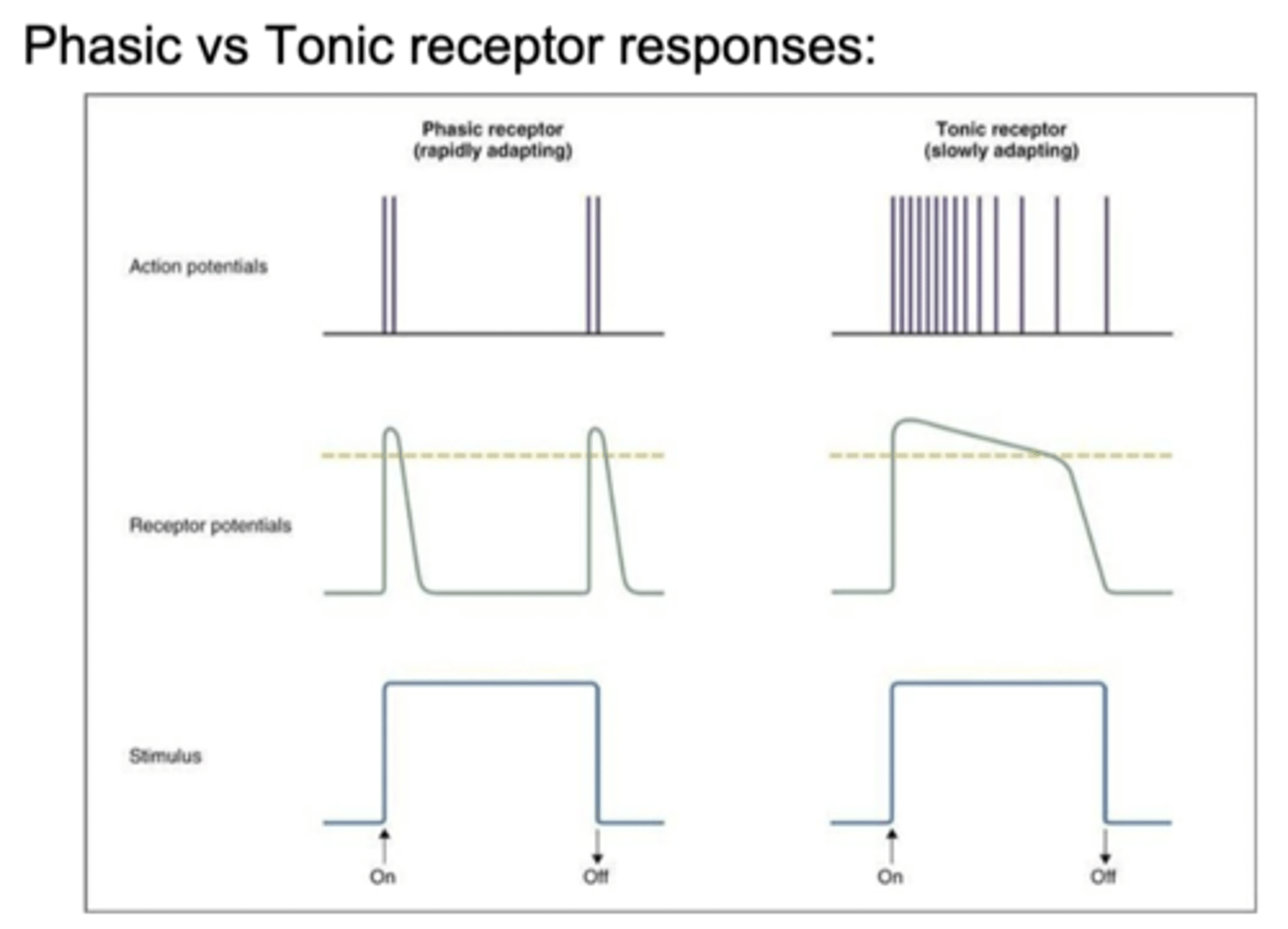
receptors are classified by stimulus ________
receptors are classified by stimulus modality
list the 5 types of receptor classifications.
photoreceptors, thermoreceptors, nociceptors, chemoreceptors, and mechanoreceptors
________ - located in the ________, respond to ________, provides sense of ________
photoreceptors
________ - respond to ________ and ________
thermoreceptors - respond to heat and cold
________ - respond to tissue ________, situations threatening ________, activation of these receptors produces sensation of ________
nociceptors - respond to tissue injury, situations threatening damage, activation of these receptors produces sensation of pain
________ - respond to ________, ex: ________, tastes, body ________ composition
chemoreceptors - respond to chemicals, ex: odors, tastes, body fluid composition
________ - respond to physical ________, ex: vibration, ________, ________, stretch, ________, the organs of ________ and balance also use ________
mechanoreceptors - respond to physical deformation, ex: vibration, touch, pressure, stretch, tension, the organs of hearing and balance also use mechanoreceptors
________ - respond to ________ and ________
- they are ________ nerve endings located in the ________, ________ muscles, ________, and ________
- uses the same ________ as ________ sensations - sends information along the following pathway: ________ formation in the ________ -> ________ -> primary ________ ________
thermoreceptors - respond to heat and cold
- they are free nerve endings located in the dermis, skeletal muscles, liver, and hypothalamus
- uses the same pathways as pain sensations - sends information along the following pathway: reticular formation in the brainstem -> thalamus -> primary sensory cortex
________ - respond to ________ stimuli, they are ________ nerve endings with LARGE/SMALL ________ ________
commonly found:
- in the ________ portions of the ________
- in ________ capsules
- within the ________ of ________
- around the ________ of ________ vessels
- ________ is important to ________ and survival since it warns us about problems that may be life ________
- ________ - inability to feel ________
- ________ - increases ________ to ________
nociceptors - respond to noxious stimuli, they are free nerve endings with LARGE receptive fields
commonly found:
- in the superficial portions of the skin
- in joint capsules
- within the periostea of bones
- around the walls of blood vessels
- pain is important to homeostasis and survival since it warns us about problems that may be life threatening
- analgesia - inability to feel pain
- hypergesia - increased sensitivity to pain
name the disorder that causes increased sensitivity to pain
hypergesia
name the disorder that causes an inability to feel pain
analgesia
________ (cont.)
may be sensitive to:
- ________ extremes
- ________ damage
- dissolved ________, such as ________ released by ________ cell
- ________ information sent to the ________ by 2 types of axons:
1) type ________ - ________, ________ fibers - ________, sends prickling/________ pain (ex: deep cut, injection through skin), reach CNS ________ to trigger ________ reflexes before reaching primary ________ cortex
2) type ________ - ________, ________ fibers - ________, sends burning/aching/________ pain, activates reticular ________ and t________, not very ________ to exact location of area affected
nociceptors (cont.)
may be sensitive to:
- temperature extremes
- mechanical damage
- dissolved chemicals, such as chemicals released by injured cells
types of axons:
1) type A - large, myelinated, fast fibers - fast, sends prickling /fast pain (ex: deep cut, injection through skin), reach CNS fast to trigger somatic reflexes before reaching primary somatosensory cortex
2) type C f- small, unmyelinated fibers - slow, sends burning/aching/slow pain, activates reticular formation and thalamus - not very specific to exact location of area affected
________ - respond only to ________-soluble and ________-soluble substances dissolved in fluid
- these receptors are ________
- uses the same pathway as ________ sensations - sends information along the following pathway: ________ formation in the ________ -> t________ -> primary ________ cortex
- receptors that monitor ________, ________ dioxide (________) and ________ (________) levels in arterial blood that are located at:
~ ________ bodies - located near the ________ of the internal ________ arteries on each side of the ________
~ ________ bodies - located between the major ________ of the ________ arch
chemoreceptors - respond only to water-soluble and lipid-soluble substances dissolved in fluid
- these receptors are exhibit
- uses the same pathway as pain sensations - sends information along the following pathway: reticular formation in the brainstem -> thalamus -> primary somatosensory cortex
- receptors that monitor pH, carbon dioxide (CO), and oxygen (O2) levels in arterial blood that are located at:
- carotid bodies - located near the origin of the internal carotid arteries on each side of the neck
- aortic bodies - located between the major branches of the aortic arch
________ - respond to stimuli that physically ________ the receptor's ________ membrane; contains ________-gated ion channels that open/close in response to ________, ________, t________, etc.
3 classes of ________:
1) ________ receptors
2) ________
3) ________
mechanoreceptors - respond to stimuli that physically distort the receptor's plasma membrane; contains mechanically-gated ion channels that open/close in response to stretching , compression, twisting, etc,
3 classes of mechanoreceptors:
1) tactile receptors
2) baroreceptors
3) proprioceptors
list the 3 classes of mechanoreceptors
tactile receptors, baroreceptors, proprioceptors
________ receptors - include ________ touch and ________ receptors
________ touch and ________ receptors:
- very ________
- have a relatively ________ receptive field
- provides detailed information about the stimulus, including:
~ exact ________
~ s________
~ s________
~ ________
~ movement at the ________
tactile receptors - include fine touch and pressure receptors
fine touch and pressure receptors:
- very sensitive
- have a relatively narrow receptive field
- provides detailed information about the stimulus, including:
~ exact location
~ shape
~ size
~ texture
~ movement at the location
________ receptors (cont.) - include ________ touch receptors
________ touch and ________ pressure receptors:
- less ________
- have a relatively ________ receptive field, poor ________ of stimulus
- provides ________ information about the stimulus
tactile receptors (cont.) - include crude touch receptors
crude touch and crude pressure receptors:
- less sensitive
- have a relatively large receptive field, poor localization of stimulus
- provides little information about the stimulus
________ - monitors change in ________
- consists of ________ nerve endings that branch within ________ tissues (ex: in the walls of distensible organs such as ________ vessels, ________ organs, etc.)
- ________ receptor - responds immediately to the change in ________ and adapts rapidly
baroreceptors - monitors change in pressure
- consists of free nerve endings that branch within elastic tissues ex: in the walls of distensible organs such as blood vessels, digestive organs, etc.)
- phasic receptor - responds immediately to the change in pressure and adapts rapidly
________ - monitors the ________ of joints, ________ in tendons and ligaments, and the amount of ________ muscle ________
3 major groups of ________:
1) ________ in ________ capsules - ________ nerve endings that detect ________, tension, ________ at the joint
2) ________ tendon organs - located between ________ muscle and its ________, the monitor ________ tension generated during ________ muscle contraction and are stimulated by tension in the ________
3) ________ ________ - monitor ________ muscle ________, used to trigger ________ reflexes
proprioceptors - monitors the position of joints, tension in tendons and ligaments, and the amount of skeletal muscle contraction
3 major groups of proprioceptors:
1) receptors in joint capsules - free nerve endings that detect pressure, tension, movement at the joint
2) golgi tendon organs - located between skeletal muscle and its tendon, they monitor external tension generated during skeletal muscle contraction and are stimulated by tension in the tendon
3) muscle spindles - monitor skeletal muscle length, used to trigger stretch reflexes
________ nerve endings - ________ with NO ________ tissue wrapping
unencapsulated nerve endings - dendrites with NO connective tissue wrapping
________ nerve endings - ________ receptors with ________ receptive fields that are bare ________ that detect ________ and (________ and cold receptors) and pain (________)
- abundant in ________ and ________ membranes
free nerve endings - tonic receptors with small receptive fields that are bare dendrites that detect temperature (warm and cold receptors) and pain (nociceptors)
________ (________) discs - ________ receptors with ________ receptive fields that are ________ nerve endings that terminate at ________ cells in ________ layer of epidermis, very ________ that detect l________, touch, ________, edges, ________
tactile (Merkel) discs - tonic receptors with small receptive fields that are flattened nerve endings that terminate at tactile cells in basal layer of epidermis, very sensitive that detect light, touch, texture, edges, shapes
________ receptors ( ________ hair ________) - ________ receptors that are ________ coiled around a hair ________ and respond to movements of ________ - very ________
hair receptors (root hair plexuses) - phasic receptors that are dendrites coiled around a hair follicle and respond to movements of hair - very sensitive
________ nerve endings - ________ fibers wrapped in ________ cells or ________ tissue; wrapping enhances ________ or ________ of response
encapsulated nerve endings - nerve fibers wrapped in glial cells or connective tissue; wrapping enhances sensitivity or selectivity of response
________ (_________) corpuscle - ________ or ________ nerve fibers within fluid-filled capsule of flattened ________ cells
- ________ receptor that detects ________/light touch and ________
- linked to edges of dermal ________, especially concentrated in the ________ areas of skin (fingertips, ________, eyelids, ________, genitals)
tactile (Meissner) corpuscle - 2 or 3 nerve fibers within fluid-filled capsule of flattened Schwann cells
- phasic receptor that detects fine/light touch and texture
- linked to edges of dermal papillae, especially concentrated in the hairless areas of skin (fingertips, palms, eyelids, nipples, genitals)
________ bulbs (________ ________ bulbs) - ________ nerve fiber surrounded by ________ tissue sheath
- functionally similar to ________ corpuscles, but found in ________ membranes
end bulbs (Krause end bulbs) - sensory nerve fiber surrounded by connective tissue sheath
- functionally similar to tactile corpuscles, but found in mucous membranes
________ (________) corpuscles - flattened, elongated capsules containing a few ________ axons in an ________ fibrous capsule, ________ receptors located in the ________ layer of the dermis
- detect ________ touch, pressure, ________ of skin, ________ of fingertips, and ________ movements
bulbous (Ruffini) corpuscles - flattened, elongated capsules containing a few myelinated axons in an incomplete fibrous capsule, tonic receptors located in the reticular layer of the dermis
- detect heavy touch, pressure, stretching of skin, deformation of fingertips, and joint movements
________ (________) corpuscles - large, ovoid receptors with a single ________ surrounded by layers of ________ cells and ________
- ________ receptor that detects ________ pressure and ________ - most ________ to pulsing or ________-frequency vibration
- found in the ________ of bone, ________ capsules, some ________, and deep in the ________ (especially on hands, ________, breasts, and ________)
lamellar (Pacinian) corpuscles - large, ovoid receptors with a single dendrite surrounded by layers of flattened Schwann cells and fibroblasts
- phasic receptor that detects deep pressure and vibration - most sensitive to pulsing or high-frequency vibration
- found in the periosteum of bone, joint capsules, some viscera, and deep in the dermic (especially on hands, feet, breasts, and genitals)
receptors of the general senses image figure 16.2
image
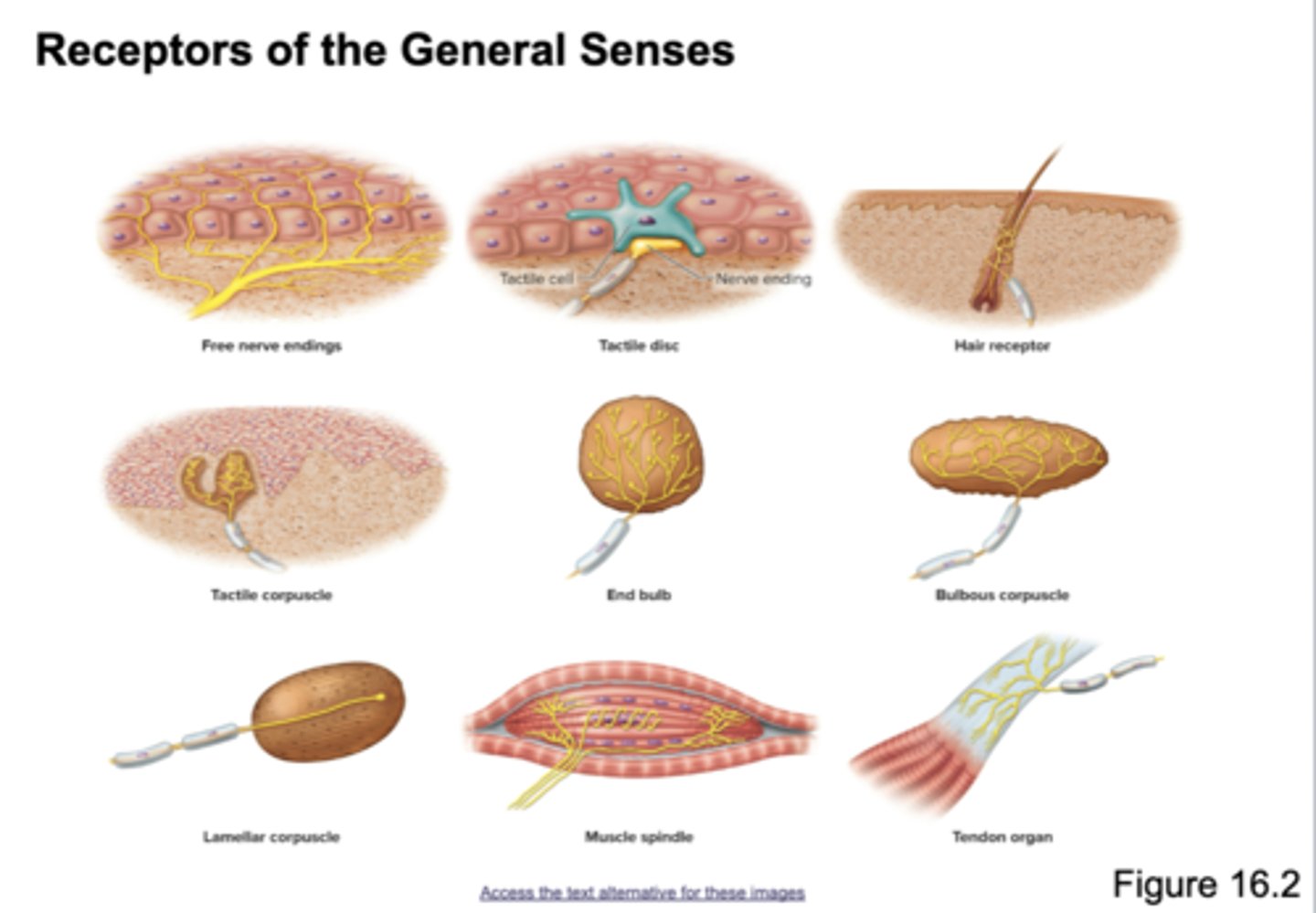
list the 3 categories for receptors classified by the ORIGIN of stimuli
(E I P)
exteroceptors, interoceptors, proprioceptors
classification by origin of stimuli:
1) ________ - sense stimuli ________ to the body
- includes receptors for ________, hearing, ________, smell, and ________ sensations such as ________, heat, ________, and ________
2) ________ - detect ________ stimuli
- ________, intestines, ________
- stretch, ________, visceral ________, ________
3) ________ - sense ________ position and movements, purely ________ sensation (no ________ in visceral organs of ________ and ________ cavities)
- receptors are located in ________, tendons, and ________ capsules
classification by origin of stimuli:
1) exteroceptors - sense stimuli external to the body
- includes receptors for vision, hearing, taste, smell, and cutaneous sensations such as touch, heat, cold, and pain
2) interoceptors - detect internal stimuli
- stomach, intestines, bladder
- stretch, pressure, visceral pain, nausea
3) proprioceptors - sense body position and movements, purely somatic sensation (no proprioceptors in visceral organs of thoracic and abdominopelvic cavities)
- receptors are located in muscles, tendons, and joint capsules
list the 2 categories for receptors classified by DISTRIBUTION
(G S)
general (somatosensory, somesthetic) senses, special senses
classification by distribution:
1) ________ (somatosensory, ________) senses - widely distributed in ________, muscles, tendons, ________, ________, receptors may be ________, and some are just bare ________
- touch, ________, stretch, ________, cold, ________, ________ pressure, ________ composition
2) ________ senses - limited to ________, innervated by ________ nerves, and involve complex ________ organs
- includes structures specialized for ________, ________, ________, ________, and smell
classification by distribution:
1) general (somatosensory, somesthetic) senses - widely distributed in skin, muscles, tendons, joints, viscera, receptors may be simple, and some are just bare dendrites
- touch, pressure, stretch, heat, cold, pain, blood pressure, blood composition
2) special senses - limited to head, innervated by cranial nerves, and involve complex sense organs
- includes structures specialized for vision, hearing, equilibrium, taste, and smell
________ signals are transmitted to or from the ________ in order to be processed for a proper response
electrical signals are transmitted to or from the CNS in order to be processed for a proper response
________ division of the nervous system
- ________ - detect stimuli, ________ neurons - relays ________ information toward ________ (receives input from ________, uses ________ to send it to ________)
- ________ pathways - nerves, ________, and tracts that deliver sensory information TO/FROM the ________
afferent division of the nervous system
- receptors - detect stimuli, sensory neurons - relays sensory information toward CNS (receives input from dendrites, uses axons to send it to CNS)
- sensory pathways - nerves, nuclei, and tracts that deliver sensory information TO the CNS
________ division of the nervous system
- ________ - contain ________ bodies of ________ neurons
- ________ neurons - send commands to ________ through motor ________ (axons in the ________) or nerves (axons in the ________)
efferent division of the nervous system
- nuclei - contain cell bodies of motor neurons
- motor neurons - send commands to effectors through motor tracts (axons in the CNS) or nerves (axons in the PNS)
sensory pathways:
- deliver ________ and ________ sensory information to their final destinations inside the CNS using:
~ ________ - bundle of ________ located in the PNS
~ ________ - cluster of ________ bodies located in the CNS
~ ________ - bundle of ________ located in the ________
sensory pathways:
- deliver somatic and visceral sensory information to their final destinations inside the CNS using:
~ nerves - bundles of axons located in the PNS
~ nuclei - cluster of cell bodies located in the CNS
~ tracts - bundle of axons located in the CNS
example of a sensory pathway:
________ from arm bring sensory information to ________ ________
- axon ________ synapse onto ________ in spinal cord (________ bodies clustered together - ________)
- these ________ bodies send info UP/DOWN to brain through ________ bundles (now called ________ since inside the CNS)
example of a sensory pathway:
nerves from arm bring sensory information to spinal cord
- axon terminal synapse onto interneurons in spinal cord (cell bodies clustered together - nucleus)
- these cell bodies send info up to brain through axon bundles (now called tracts since inside the CNS)
________ - bundle of axons located in the PNS
nerves - bundle of axons located in the PNS
________ - cluster of cell bodies located in the CNS
nuclei - cluster of cell bodies located in the CNS
________ - bundle of axons located in the CNS
tracts - bundle of axons located in the CNS
somatic nervous system (SNS)
- ________ neurons and pathways that provides VOLUNTARY/INVOLUNTARY control of ________ muscles
- ________ motor commands travel from motor centers in the ________ along somatic motor pathways of:
~ ________ nuclei (in the ________)
~ ________ (in the CNS)
~ nerves (in the ________)
autonomic nervous system (ANS)
- sends INVOLUNTARY/VOLUNTARY commands to ________ (glands, organs)
- 2 divisions:
1) ________ division
2) ________ division
somatic nervous system (SNS)
- motor neurons and pathways that provides VOLUNTary control of skeletal muscles
- somatic motor commands travel from motor centers in the brain along somatic motor pathways of:
~ motor nuclei (in the CNS)
~ tracts (in the CNS)
~ nerves (in the PNS)
autonomic nervous system (ANS)
- sends INVOLUNTARY commands to viscera (glands, organs)
- 2 divisions
1) sympathetic division
2) parasympathetic division
________ projection - transmission of information from ________ to specific location in ________ cortex; signals travel along ________ pathway
most somatosensory signals travel by way of 3 neurons:
1) ________-________ neuron
2) ________-________ neuron
3) ________-________ neuron
sensory projection - transmission of information from receptors to specific location in cerebral cortex; signals travel along projection pathway
most somatosensory signals travel by way of 3 neurons:
1) first-order neuron
2) second-order neuron
3) third-order neuron
________-________ neuron:
- signals from ________ travel to ________ or ________ via cranial nerves
- signals from below ________ enters ________ horn of ________ ________ via ________ root of the spinal nerves
- ________, pressure, and ________ fibers are LARGE/SMALL, UNMYELINATED/MYELINATED, SLOW/FAST
- ________ and cold fibers are LARGE/SMALL, UNMYELINATED/MYELINATED, SLOWER/FASTER
first-order neurons
- signals from brain travels to pons of medulla via cranial nerves
- signals from below brain enters posterior horn of spinal cord via dorsal root of the spinal nerves
- touch, pressure, and proprioception fibers are LARGE, MYELINATED, FAST
- heat and cold fibers are SMALL, UNMYELINATED, SLOWEW
________-________ neuron:
- ________ (cross) to opposite side (________) in ________ cord, ________, or ________
- end in ________, except for proprioception, which ends in ________
second-order neuron:
- decussate (cross) to opposite side (contralateral) in spinal cord, medulla, or pons
- end in thalamus, except for proprioception, which ends in cerebellum
________- ________ neuron:
- ________ to ________ ________ cortex of ________
third-order neuron:
- thalamus to primary somatosensory cortex of cerebrum
projection pathways for pain image figure 16.3
image
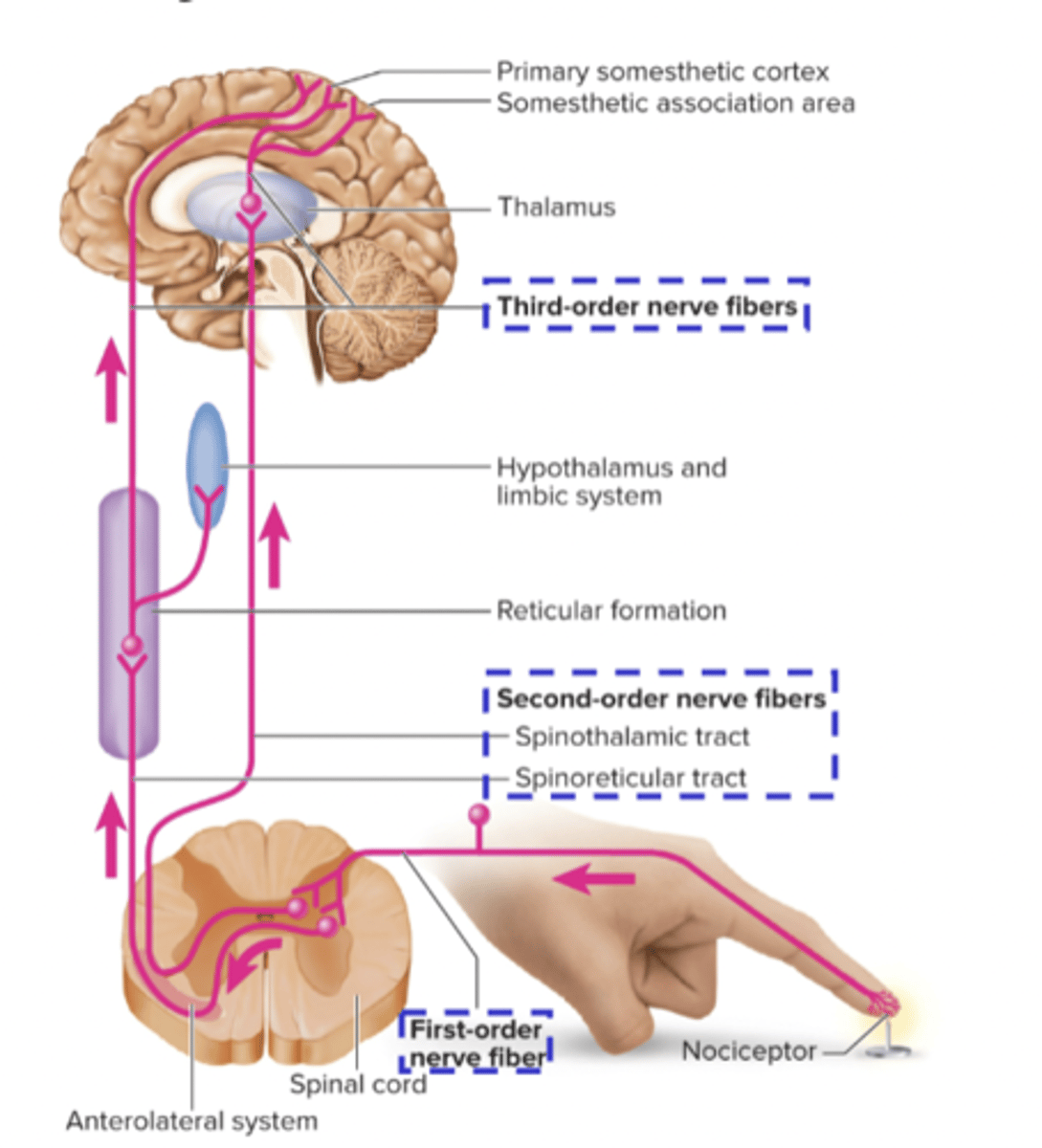
________ sensory pathways:
- carry ________ information from the ________ and ________ of the ________ wall, ________, neck, and ________
- 3 major ________ sensory pathways:
1) the ________ pathway
2) the ________ ________ pathway
3) the ________ pathway
somatic sensory pathways:
- carry sensory information from the skin and musculature of the body wall, head, neck, and limbs
- 3 major somatic sensory pathways:
1) the spinothalamic pathway
2) the posterior column pathway
3) the spinocerebellar pathway
the ________ pathway:
- provides UNCONSCIOUS/CONSCIOUS sensations of poorly ________ ("________") touch, ________, ________, and temperature
- ________-________ neurons: axons of ________-________ sensory neurons enter ________ ________ and synapse on ________-________ neurons within ANTERIOR/POSTERIOR GRAY/WHITE horns
- ________-________ neurons: cross to the ________ side of the ________ ________ and then ascends UP the ________ ________ within the ________ or lateral ________ tracts
~ ________ tracts carry ________ touch and ________
~ ________ tracts carry ________ and ________
- ________-________ neurons: synapse in the ________. The information is sorted and processed before being transmitted to the ________ ________ cortex
the spinothalamic pathway:
- provides CONSCIOUS sensations of poorly localized ("crude') touch, pressure, pain, and temperature
- first-order neurons: axons of first-order sensory neurons enter spinal cord and synapse on second-order neurons within POSTERIOR GRAY horns
- second-order neurons: cross to the opposite side of the spinal cord and then ascends UP the spinal cord within the anterior or lateral spinothalamic tracts
~ anterior tracts carry crude touch and pressure
~ lateral tracts carry pain and temperature
- third-order neurons: synapse in the thalamus. The information is sorted and processed before being transmitted to the primary somatosensory cortex
the ________ ________ pathway:
- carries highly ________ "________" touch, ________, ________, and ________
- ________-________ neurons: enter the ________ ________ and ascend UP the ________ (same) side of the ________ ________ and synapse onto ________-________ neurons at the ________ ________
- ________-________ neurons: project axons that ________ to the ________ side and ascend to the thalamus
- ________-________ neurons: located in the ________, receives input from ________-________ neurons, processes the information and sends the information back to the ________ cortex
the posterior column pathway:
- carries highly localized "fine" touch, pressure, vibration, and proprioception
- first-order neurons: enter the spinal cord and ascend UP the ipsilateral (same) side of the spinal cord and synapse onto second-order neurons at the medulla oblongata
- second-order neurons: project axons that cross to the contralateral side and ascend to the thalamus
- third-order neurons: located in the thalamus, receives input from second-order neurons, processes the information and sends the information back to the somatosensory cortex
the ________ pathway:
- carries ________ information from ________ muscles, ________, and ________
- information terminates at ________ for processing
the spinocerebellar pathway:
- carries proprioceptive information from skeletal muscles, tendons, and joints
- information terminates at cerebellum for processing
________ pain is separated into 3 kinds by ________:
1) ________ pain
2) ________ ________ pain
3) ________ ________ pain
nociceptive pain is separated into 3 kinds by origin:
1) visceral pain
2) deep somatic pain
3) superficial pain
________ pain - arises from ________ ________
- ________, dull, and ________ to locate
- creates sensations of ________, cramping, ________
- caused by ________, ________ irritation, i________
visceral pain - arises from internal organs
- diffuses, dull, and hard to locate
- creates sensations of squeezing, cramping, nausea
- caused by stretch, chemical irritation, ischemia
________ ________ pain - arises from ________, ________, ________
- examples: pain of ________, sprains, ________ fractures
- can be caused by excessive ________ (as in ________ sprain or pulled ________)
deep somatic pain - arises from bones, joints, muscles
- examples: pain of arthritis, sprains, bone fractures
- can be caused by excessive stretch (as in ankle sprain or pulled muscle)
________ ________ pain - usually arises from the ________
- examples: pains of ________, ________, insect ________
superficial somatic pain - usually arises from the skin
- examples: pain of cuts, burns, insect stings
2 types of ________ fibers involved in ________ responses:
1) ________ pain
2) ________ pain
2 types of nerve fibers involved in pain responses:
1) fast pain
2) slow pain
________ pain - ________, ________, ________ pain
- signal carried by ________ type ________ nerve fibers
- ________ conduction speeds up to ________ to ________ m/s
- also called ________ ________ because we can tell exactly where it is coming from
fast pain - immediate, sharp, localized pain
- signal carried by myelinated type A nerve fibers
- fast conduction speeds up to 12 to 30 m/s
- also called discriminative pain because we can tell exactly where it is coming from
________ pain - ________, ________, ________ pain
- signal carried by ________ type ________ nerve fibers
- ________ signal conduction at only ________ to ________ m/s
- ________-lasting and more ________ (less ________) pain
slow pain - burning, dull, aching pain
- signal carried by unmyelinated type C nerve fibers
- slower signal conduction at only 0.5 to 2 m/s
- longer-lasting and more diffuse (less localized pain)
projection pathways for pain:
- pain signals from ________ travel to ________ via ________ nerves:
~ ________-________ neurons travel in ________ nerves ________, ________, 9, and ________ and end in the ________ ________
- ________ pain signals from ________ and below travel through ________ tract:
~ ________ tract carries most UNCONSCIOUS/CONSCIOUS, ________ pain
projection pathways for pain:
- pain signals from head travel to brainstem via cranial nerves:
~ first-order neurons travel in cranial nerves 5, 7, 9 and 10 and end in the medulla oblongata
- somatic pain signals from head and below travel through spinothalamic tract:
~ spinothalamic tract carries most CONSCIOUS, somatic pain
porjection pathways for pain image figure 16.3
image
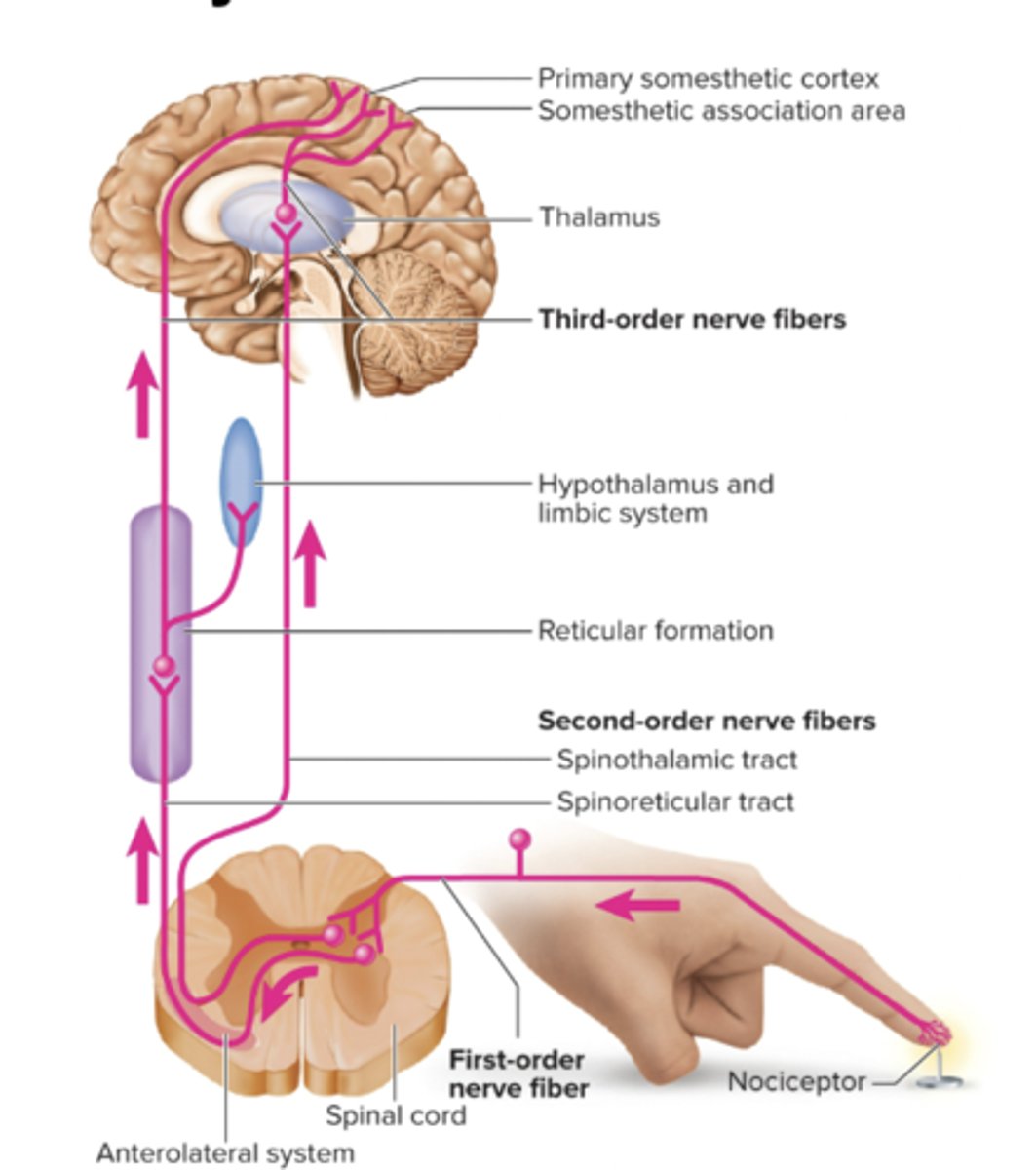
________ pain - pain in ________ often perceived as originating from ________ site (such as ________)
- results in ________ of neural pathways in ________
- ________ CAN/CANNOT distinguish source
- example: ________ pain felt in shoulder or arm because both send pain input to spinal cord segments ________ to ________
referred pain - pain in viscera often perceived as originating from superficial site (such as skin)
- results in convergence of neural pathways in CNS
- brain CANNOT distinguish source
- example: heart pain felt in shoulder or arm because both send pain input to spinal cord segments T1 to T5
referred pain image figure 16.4
image

________ modulation of pain:
- pain is ________, highly ________, and influenced by ________ and ________ state
- CNS has ________ (________-________) mechanisms
- ________ opioids - ________ peptides secreted by CNS, ________, ________ tract, other organs
~ act as ________ that block ________ and give ________
~ e________, e________, d________
- opioids block pain through ________ ________
~ stops pain signals at ________ horn of ________ ________
~ ________ stimulated to release ________
~ inhibit ________-________ pain neurons
CNS modulation of pain:
- pain is subjective, highly variable, and influenced by physical and mental state
- CNS has analgesic (pain-reliving) mechanisms
- endogenous opioids - analgesic peptides secreted by CNS, pituitary, digestive tract, other organs
~ act as neuromodulators that block pain and give pleasure
~ enkephalins, endorphins, dynorphins
- opioids block pain through spinal gating
~ stops pain signals at posterior horn of spinal cord
~ interneurons stimulated to release enkephalins
~ inhibit second-order pain neurons
spinal gating of pain signals image figure 16.5
image

________ ________ sclerosis (ALS)
- progressive degenerative disorder affecting ________ neurons in the ________ ________, ________ ________, and ________ hemisphere. Death of these neurons cause ________ in associated ________ muscles
~ cause: ________ by ________-________% in people; rest, ________
~ treatment: ________ medications such as r________ cannot reverse damage cause by ________, but can ________ symptoms
Amyotrophic Lateral Sclerosis (ALS)
- progressive degenerative disorder affecting motor neurons in the spinal cord, brain stem, and cerebral hemisphere. Death of these neurons can cause atrophy in associated muscles
~ cause: inherited by 5-10% in people; rest, unknown
~ treatment: oral medications such as riluzole cannot reverse damage caused by ALS, but can mitigate symptoms
________ ________ (CP)
- number of disorders affecting ________ motor control, ________ skills, ________/________, memory, ________, ________
~ dysfunction is NOT ________, can appear during ________ or ________ and persist through entire life
- possible causes: usually stressful ________, maternal exposure to ________, genetic defect affecting ________ pathway development
- treatment: ________ - muscle ________ and pain ________, various ________ (________/speech, etc.)
Cerebral Palsy (CP)
- number of disorders affecting voluntary motor control, motor skills, posture/balance, memory, speech, learning
- dysfunction is NOT progressive, can appear during infancy or childhood and persist through entire life
- possible causes: usually stressful birth, maternal exposure to drugs, genetic defect affecting motor pathway development
- treatment: medication - muscle relaxants and pain relievers, various therapies (physical/speech, etc.)